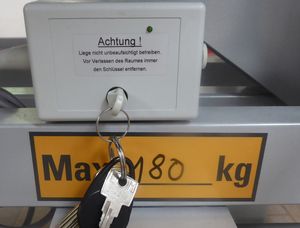KANBrief 1/19

Treatment tables with electric height adjustment are in widespread use in physiotherapy practices and hospitals. Two workers were recently trapped beneath such tables, suffering fatal injuries. In January 2019, KAN convened a meeting of experts representing stakeholders for discussion of their respective positions and the complex situation. A number of projects were initiated with the aim of reducing the risk presented by new and legacy treatment tables.
On two occasions, a fatal accident occurred when a worker underneath a treatment table inadvertently actuated the height-adjustment control on the floor with their knee. This caused the table to be lowered, trapping the worker. Further accidents are known to have occurred in Germany and elsewhere in which workers, patients and children suffered crushing or fractures or in some cases were even killed. A risk exists in particular on tables employing a scissor or hinge mechanism for height adjustment. A product standard for treatment tables does not exist at this point in time.
The risk of persons being trapped beneath treatment tables has been known for some time. In August 2004, the German Federal Institute for Drugs and Medical Devices (BfArM) published a recommendation (in german) describing the basic safety objectives: treatment tables with powered height adjustment should be designed such that inadvertent actuation of the height adjustment control is not possible, or is unable to present a hazard to persons. The recommendation also states examples of means for attainment of the safety objectives, such as the fitting of a safety box. A treatment table fitted with such a safety box can be deactivated when not in use, for example by withdrawal of a pin from the box.
Safety boxes of this kind are fitted to the majority of new treatment tables and have been retrofitted to many legacy tables. One of the two recent fatal accidents occurred on a treatment table fitted with a safety box: the pin had not been withdrawn. The treatment table on which the other fatal accident occurred was not equipped with a safety box. Opinions differ on whether such a safety box satisfies the specified safety requirements, since strictly speaking it constitutes an organizational measure rather than a technical measure. The effectiveness of the safety box is dependent upon the user. In practice it is not even always clear what requirements must be met by a safety box.
The purpose of the expert discussion of treatment table design convened by KAN was to bring all stakeholders (German Social Accident Insurance Institutions, BfArM, German regional authorities, operators, social partners, standards bodies, etc.) together in order to discuss firstly their different positions, and secondly possible concerted action. The topics of the discussion, which was organized in close cooperation with the German Social Accident Insurance Institution for the health and welfare services (BGW), lay primarily upon the placing of new treatment tables upon the market, and also upon legacy tables. At a rough estimate, 500,000 such tables are in use in Germany (not all of which are adjustable for height).
The need for discussion was considerable. Development of a product standard for new treatment tables was discussed: Should it be developed at national, European or international level? Should a prestandard first be developed? Conversely, is the generic standard for medical electrical devices sufficient? What safety objectives should be met, and what groups of person should be safeguarded?
Technical measures and upgrading were discussed for the legacy treatment tables: What possibilities exist? Against what criteria should these possibilities be assessed? Who would pay for upgrading? Would an operator upgrading his treatment table become a manufacturer? How the German regional governments and the German Social Accident Insurance Institutions might cooperate in surveillance activity was also discussed.
As a result of the discussion, the experts participating declared their willingness to address a range of topics in working groups:
Participants in the expert discussion intend to keep each other informed of the progress of their respective work and would welcome a further KAN expert discussion in the spring of 2020.
Dr Anna Dammann
dammann@kan.de